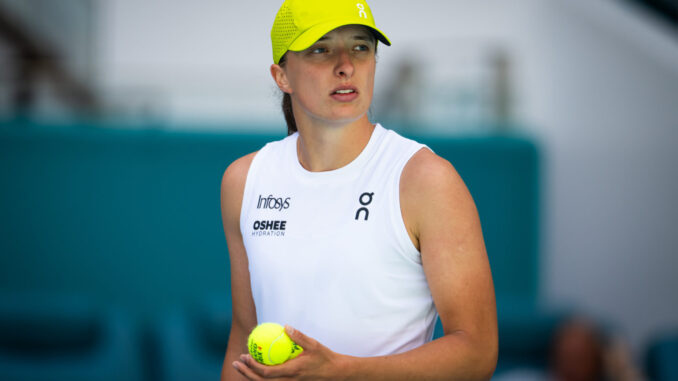
In the bustling world of professional tennis, where every match is a test of skill, stamina, and strategy, Iga Swiatek stands as a towering figure. The 23-year-old Polish superstar, ranked No. 2 in the world and a five-time Grand Slam champion, has carved out a reputation as one of the game’s most formidable forces. On March 24, 2025, as she prepared for her fourth-round showdown with Elina Svitolina at the Miami Open, Swiatek took a moment to reflect on the nuances that distinguish the men’s and women’s tours. With her trademark candor, she pointed to a subtle yet significant difference between the ATP and WTA players—a disparity in approach that shapes the rhythm of their rallies and underscores the unique dynamics of each circuit.
It all started with a question during a press conference, sparked by an observation about her prowess as a returner. Swiatek, who leads the WTA in return games won this year with a staggering 48.4% success rate from 213 games, was asked to compare her style to that of ATP giants like Rafael Nadal and Daniil Medvedev. These men are known for their deep-court positioning, often retreating several meters behind the baseline to transform defense into offense. Could such a tactic, less common among WTA players, enhance her game against the tour’s biggest servers? Swiatek’s response was both gracious and insightful, revealing a keen awareness of the tactical gulf between the two tours.
“Thanks for saying that,” she began, flashing a smile at the compliment to her returning skills. “I think for sure it’s a nice thing to have in your toolbox. I can return like that, but I feel like I can put much more pressure stepping in. I don’t feel like I’m missing a lot. I didn’t feel like I need to do that.” Her words painted a picture of a player confident in her aggressive approach, one honed by years of dominating from the front foot. But then came the crux of her observation: “For sure, guys have a little bit more power. Guys, they are taking a bit more time to build the rally and figure out the tactical side. Sometimes in WTA, girls are hitting the first ball possible, stepping in, stepping in, stepping in. We don’t have time always to come back and build a rally. But I can return like that.”
This wasn’t just a casual remark—it was a window into the contrasting rhythms of men’s and women’s tennis. On the ATP Tour, players often lean on their physicality, using their power to extend points and construct rallies like architects sketching a blueprint. Nadal, with his relentless topspin, and Medvedev, with his lanky reach, exemplify this deliberate pace, turning matches into chess games played at lightning speed. The WTA, by contrast, is a crucible of immediacy—players like Swiatek seize the initiative early, striking with precision and pace to dictate terms before the rally can settle. It’s a difference born of necessity and style, reflecting the explosive, proactive ethos that defines the women’s game.
Swiatek’s own game embodies this WTA hallmark. Her blistering forehand, averaging 3,200 revolutions per minute at its peak, and her ability to redirect balls with surgical accuracy have made her a nightmare for opponents. In Miami, she’s been untouchable on return, breaking Svitolina’s serve in their past encounters and carrying a 2-1 head-to-head edge into their latest battle. Her 2025 stats tell the story: a 48.9% return points won rate, a testament to her knack for pouncing on serves rather than waiting them out. “I’ve always liked stepping in,” she’s said in the past, a philosophy that’s fueled her rise from a teenage Roland Garros champion in 2020 to a global icon with over $33 million in prize money.
Yet, her ability to adapt shines through. She acknowledges the ATP’s deeper positioning as a viable tool—one she’s capable of wielding when needed. Against the tour’s heaviest hitters, like Aryna Sabalenka or Elena Rybakina, she’s occasionally dropped back, absorbing power before countering with her own. But it’s her preference for aggression, her refusal to let rallies simmer, that sets her apart on the WTA landscape. “We don’t have time always to come back,” she noted, a subtle nod to the urgency that drives women’s tennis—a relentless pursuit of the first strike.
As Swiatek prepares to face Svitolina, a tenacious baseliner with a knack for grinding out points, this contrast takes on new weight. Their match promises a clash of styles—Swiatek’s proactive brilliance against Svitolina’s patient resilience. For Swiatek, it’s another chance to showcase why she’s a cut above, blending WTA intensity with a versatility that keeps her opponents guessing. Her observation isn’t just a comparison—it’s a celebration of the diversity that makes tennis thrilling, a sport where power and pace dance in different rhythms across its two tours. And in Miami, under the Florida sun, Swiatek’s ready to step in and write the next chapter of her extraordinary story.
Leave a Reply